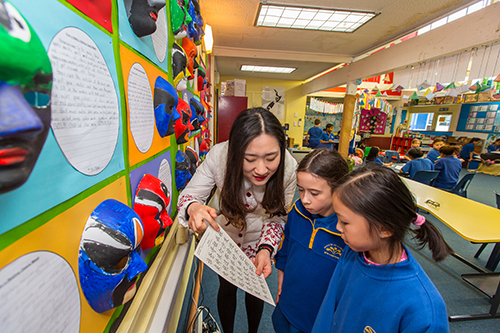Early start on Mandarin opens doors to wider world
Originally published in Education Gazette (ISSUE: VOLUME 96, NUMBER 15)
New Lynn Primary students are studying Mandarin language and Chinese culture as part of an approach to celebrate and normalise diversity.

Mei Hanxue, Mandarin language assistant, with students in the Mandarin class at New Lynn Primary School in Auckland.
When a group of Chinese Navy sailors visited a west Auckland primary school recently, children as young as six were able to test their newly acquired Mandarin conversation skills in a group chat.
Every student at New Lynn Primary is studying Mandarin language and Chinese culture for one hour a week as part of the school’s celebration of cultural diversity and support for language development. They learn about diverse subjects such as Chinese opera, dance, painting and acrobatics and kung fu, and periodically the classes host visitors from China – including musicians and artists, as well as the recent visit by Chinese Navy personnel – which lets the budding young linguists try out their new vocabulary on native speakers.
The school is one of 30 junior schools around New Zealand at which all the students are learning a Chinese language. More than 52,000 students are learning Chinese in New Zealand primary schools.
School principal Greg Roebuck says it has huge benefits.
“Learning Mandarin and Chinese culture is just one part of a bigger approach to experiencing other cultures. We want to make that diversity visible, and to normalise it. It’s important for their future lives for young people to have experiences beyond their own culture and to connect globally.”
The school has 356 students from 15 nationalities, and only 5 percent are from Chinese families.
Māori culture and te reo Māori are also taught and integrated into everyday teaching and learning, so children at the school are gaining skills in three languages while appreciating and understanding cultural differences.
“When it comes to language, the earlier you start, the better,” says Greg.
China is New Zealand’s biggest trading partner and the links between the two nations are fast expanding.
International evidence shows learning a second language can also contribute to the development of a student’s literacy skills in their first language.
In August 2014 the Government committed $10 million over five years to support Asian language learning for all students.
As with many schools in Auckland today, New Lynn Primary is a melting pot of nationalities, so its teaching philosophy reflects the local community.
“The children value and enjoy the Chinese culture classes. It is challenging and stimulates curiosity and inquiry learning. They also study other cultures represented among the students at our school. All this opens doors to the wider world,” Greg says.
Doors of another kind are about to open for the school – new classroom doors. New Lynn is one of Auckland’s high-growth areas, with its population rising fast due to intensification, so the school is about to get a brand-new, modern classroom block.
The eight-classroom building project has been managed by the Ministry of Education and is now almost complete. The block has flexible learning spaces and 21st-century facilities. Greg says the upgrade will advance educational opportunities as well as allow for future roll growth for the school.
“The learning spaces will allow different settings that suit different learning styles and processes.
“There’ll be a strong emphasis on digital technology to empower our students to self-manage and shape their own curriculum. e-Learning skills and digital literacy are the key to lifelong learning, which is a key goal. All of our teaching is underpinned by technology.”
